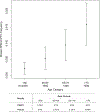Detectible mosaic truncating PPM1D mutations, age and breast cancer risk
- PMID: 30850729
- PMCID: PMC8211387
- DOI: 10.1038/s10038-019-0589-1
Detectible mosaic truncating PPM1D mutations, age and breast cancer risk
Abstract
Mosaic protein truncating variants (PTVs) in the phosphatase, Mg2+/Mn2+dependent 1D (PPM1D) gene in blood-derived DNA have been associated with increased risk of breast cancer. We analyzed PPM1D PTVs in blood from 3817 breast cancer cases and 3058 controls by deep sequencing of a previously defined region in exon 6 of PPM1D. We identified 50 of 6875 (0.73%) participants having a mosaic PPM1D PTV. We observed a higher frequency of mosaic PPM1D PTVs with increasing age (Ptrend = 2.9 × 10-6). We did not observe an overall association between PPM1D PTVs and increased breast cancer risk (OR = 1.51, 95% CI = 0.84-2.71). Evidence for an association was observed in a subset of cases with DNA collected 1-year or more before breast cancer diagnosis (OR = 3.44, 95% CI = 1.62-7.30, P-value = 0.001); however, no significant association was observed for the larger series of cases with DNA collected post diagnosis (OR = 1.01, 95% CI = 0.51-2.01, P-value = 0.98). Our study indicates that the PPM1D PTVs are present at higher rates than previously reported and the frequency of PPM1D PTVs increases with age. We observed limited evidence for an association between mosaic PPM1D PTVs and breast cancer risk, suggesting mosaic PPM1D PTVs in the blood likely do not influence risk of breast cancer.
Conflict of interest statement
Compliance with ethical standards
Conflict of interest The authors declare that they have no conflict of interest.
Figures


References
-
- Li J, Yang Y, Peng Y, Austin RJ, van Eyndhoven WG, Nguyen KC, et al. Oncogenic properties of PPM1D located within a breast cancer amplification epicenter at 17q23. Nat Genet. 2002;31:133–4. - PubMed
MeSH terms
Substances
Grants and funding
LinkOut - more resources
Full Text Sources
Medical
